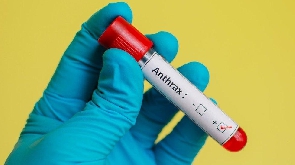One pesin plus 30 animals don die sake of di outbreak of Anthrax disease for di Upper East Region of northern Ghana.
Authorities wey give di informate also tok say dem don identify 13 suspected cases among humans.
Health authorities add say dem don send samples go laboratory for further investigation and dem dey trace pipo wey get close contact wit those wey dey affected.
Suspicion dey say dem chop meat of cows wey dey infected wit anthrax disease.
Sake of di spread of di disease, authorities for di Upper East Region of northern Ghana don ban di killing, sale and consumption of meat products for one month.
Di ban also include public movement of animals like sheep, cattle, goat, pigs and donkeys to avoid di spread of di disease.
Di authority don also increase free vaccination of animals for di region to contain di spread of di disease.
In addition to dis, Ghana goment say dem don release money to take buy about 8,000 more vaccines to help tackle di spread of di disease.
Fear dey say di disease fit spread to oda parts of di kontri.
Wetin be Anthrax Disease
Anthrax na one highly contagious bacteria disease wey dey affect animals and fit dey transmitted to human beings.
According to di Centre for Disease Control and Prevention, Anthrax na one serious infectious disease, one rod-shaped bacteria wey di name na Bacillus anthracis dey cause.
E dey occur naturally for soil and e normally dey affect domestic and wild animals all ova di world.
Pipo fit dey sick wit anthrax if dem come in contact wit infected animals or contaminated animals products.
Anthrax fit cause serious sickness in both human and animals.
How anthrax dey infect pipo
Pipo dey catch anthax wen di bacteria enta di body.
Wen anthrax bacteria enta di body, dem fit dey “activated.” Di bacteria go come multiply, spread out for di body, come begin produce toxins wey go lead to serious sickness.
Dis fit happun wen pipo breathe in bacteria, chop food or drink water wey dey contaminated wit bacteria or make bacteria enta dia skin sake of injury.
How anthrax dey infect animals
Domestic and wild animals fit become infected wen dem breathe in or ingest bacteria for contaminated soil, plants, or water.
These animals fit include cattle, sheep, goats, antelope, and deer.
For areas where domestic animals don get anthrax in di past, routine vaccination fit help prevent outbreaks.
Wetin be di symptoms of anthrax
Na four common types of anthrax infection dey, each of dem get different signs and symptoms. For most cases, symptoms dey develop within six days of exposure to di bacteria. However, e dey possible for inhalation anthrax symptoms to take more dan six weeks bifor e appear.
Cutaneous anthrax
Dis one na skin-related (cutaneous) anthrax infection, e dey enta pesin body through di skin, usually through a cut or oda sore. Na by far di most common route of di disease. Signs and symptoms include:
Gastrointestinal anthrax
Gastrointestinal anthrax infection dey happun from eating uncooked meat from infected animal.
E fit affect your gastrointestinal tract from your throat to your colon. Signs and symptoms include:
Inhalation anthrax
Inhalation anthrax dey happun wen you breathe in anthrax bacteria.
Dis na di most deadly form of di disease, and most times e dey fatal, even wit treatment. Initial signs and symptoms include:
Injection anthrax
Sabi pipo recently identify dis type of anthrax infection and so far na only for Europe dem don report am.
Dem dey catch am through injecting illegal drugs. Initial signs and symptoms include:
Where dem dey see anthrax
Anthrax dey very common for agricultural regions of
Anthrax dey more common for kontris wey no get programs wey dey routinely vaccinate animals against anthrax.




















